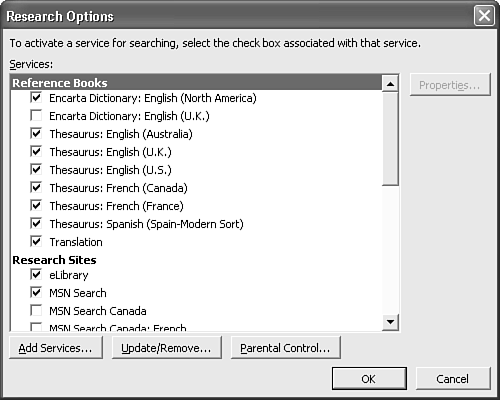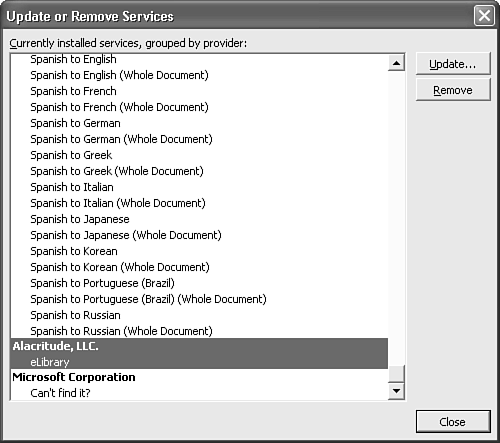Working with Additional Research Services
In addition to the Thesaurus and Translation services discussed earlier in this chapter, Word 2003 comes with several other powerful research tools, all brought together in the Research task pane. These tools are organized into three categories: |
Reference books, including the Encarta dictionary along with the thesaurus and translation tools already discussed
Research sites, including Encarta Encyclopedia, the MSN Search Web search engine, and two paid news and research sites
Business and financial sites, including delayed MSN Money stock quotes and company profiles from Thomson Gale
Many of the information resources Word can connect you with are free; for example, the Microsoft Encarta dictionary, selected articles from the Microsoft Encarta encyclopedia, and most results returned by the MSN search engine.
On the other hand, some information sources charge for access. For example, although you can read free basic Thomson Gale company profiles, deeper information?such as executive contacts at the company you're reading about?requires payment. Similarly, although you can read free article summaries from the eLibrary online research site, full text articles must be paid for, often by subscription.
To use Word's research tools, choose Tools, Research. The Research task pane appears (see Figure 8.19). In the Search For text box, enter the word or phrase you want to research. Then, from the Research Services drop-down box choose which category of sites you want to search, and click the green arrow to the right of the Search For text box.
Figure 8.19. The basic Research task pane.

When Word returns a short piece of information, you can select it in the Research task pane, right-click, and choose Copy to copy the information into your document. In most cases, Word will return links to longer content. If you click a link, the content will be displayed in Internet Explorer. From there, you can typically select and copy text, and then paste it into your document.
CAUTION
Be aware of the copyrights that may apply to content you want to use.
Controlling Research Options
As with Translation services, you can control which resources Word relies on and how it works with them. To control how Research works, click Research Options on the Research task pane. The Research Options dialog box opens (see Figure 8.20). |
Figure 8.20. Controlling research options.

Check the boxes of the research sources you want Word to utilize; clear the boxes of research sources you do not want to utilize. For example:
If you know you never want to utilize paid research services, clear the eLibrary and Factiva check boxes.
If you want deeper information related to a specific nation or region of the world, check the boxes associated with one or more of MSN's regional search engines, such as MSN Search Singapore.
To learn more about any reference source, select it and click Properties.
Adding Research Services
Microsoft expects that others will create Research services that will be accessible from Microsoft Office 2003's Research pane. These may include third-party information sites as well as internal corporate information made available through SharePoint or even corporate databases. If one of these services is available to you, add it this way: |
From the Research task pane, click Research Options.
From the Research Options dialog box, click Add Services. The Add Services dialog box appears (see Figure 8.21).
Figure 8.21. Adding a research service.

If the service is listed in the Advertised Services box, select it. If not, enter its Web address (URL) in the Address box.
Click Add.
TIP
Microsoft SharePoint collaborative sites can be added to the Research task pane without custom programming. Use the site's address, which typically follows this format:
http://your root directory/_vti_bin/search.asmx
NOTE
For detailed technical information on building research services that are compatible with Microsoft Office 2003, see msdn.microsoft.com/library/default.asp?url=/library/en-us/dno2k3ta/html/odc_customizingtheresearchpane.asp.
Using Parental Controls to Limit a Research Service
Certain research services and Web sites contain filters that eliminate content which might be inappropriate for children. Many, of course, do not?and other sites have no need for them. |
If you would like to use the parental filters that are available, or prevent your children from searching sites that do not use content filters, follow these steps:
From the Research task pane, click Research Options.
From the Research Options dialog box, click Parental Control. The Parental Control dialog box appears (see Figure 8.22).
Figure 8.22. Setting parental controls for research services.

Check the Turn on Content Filtering to Make Services Block Offensive Results check box.
If you want to prevent Word from searching sites that do not have content filters, check the Allow Users to Search Only the Services That Can Block Offensive Results check box.
In the Specify a Password box, enter a password that will be required in order to make changes to your Parental Control settings. Click OK.
In the Confirm Password dialog box, enter the same password and click OK again.
Updating or Removing a Research Service
In some cases, you may want to update the list of Research Services available to you, or remove services from the list entirely. For example, if you choose not to renew a subscription to a third-party information provider, you might no longer want to see the results it returns. To make such changes, follow these steps: |
From the Research task pane, click Research Options.
From the Research Options dialog box, click Update/Remove. The Update or Remove Services dialog box appears (see Figure 8.23).
Figure 8.23. Updating or removing groups of research services.

Select the category of services you want to update or remove.
Click Update to update a service; click Remove to remove it.
Click Close.







